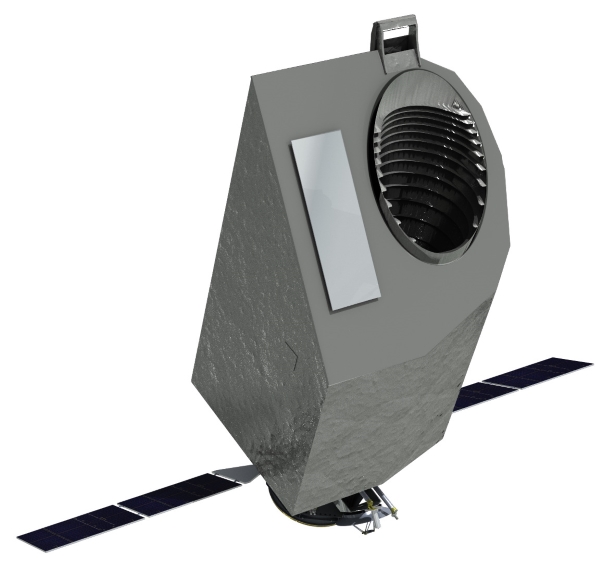July 11, 2024
Deep-Mapping the Night Sky for Hot Stars
UVEX: NASA’s new UV space telescope with an ISTA fingerprint to conquer space
The next NASA space telescope to survey the ultraviolet sky starting 2030 has the fingerprint of an astronomer from the Institute of Science and Technology Austria (ISTA). Assistant Professor Ylva Götberg is part of a large international collaboration that will study how galaxies and stars evolve, and create a community resource dataset of the entire sky. Götberg discusses the science behind the new telescope and the growing field of astronomy at ISTA.

Like every day, the Institute of Science and Technology Austria (ISTA) campus buzzes with activity. Researchers meet and discuss between experiments and simulations, and the ticking clock is all but a reminder that the next discovery might be lurking around the corner. But this is no ordinary day. Shortly before, NASA announced that a new space telescope called UVEX (UltraViolet EXplorer), a large international collaboration led by Caltech researchers, was selected for launch in 2030 to survey ultraviolet (UV) light in the entire sky. Assistant Professor Ylva Götberg, one of the first astronomers to join ISTA, has been involved from the earliest stages of developing the science case for the new telescope. She cannot hide her excitement: “Our project had been in a tie with another space telescope project for a year while NASA was evaluating to select the winning proposal. We are delighted UVEX got selected.” As one of NASA’s next ‘Astrophysics Medium-Class Explorer’ missions, UVEX will fill a long-standing gap among UV telescopes.
Hot stars, galaxies, and past UV missions
“The ultraviolet wavelength regime is the spectral range for stellar astrophysics,” says Götberg, a specialist in stripped binary stars. Near their birth or death, stars reach extreme temperatures–around 20 times that of the Sun–and attain new peaks with their higher-energy UV radiation emissions. As such, UV measurements are crucial for studying the hot stars’ temperature, composition, and evolution. “However, we have been desperately lacking extensive UV data for around 20 years,” notes Götberg. “It’s as if we are blind on one eye while looking through space.” The reasons for this partial ‘blindness’ are complex.

Luckily for life on Earth, our atmosphere filters out most UV light, but this also means that UV measurements in astronomy must be carried out from space. Among the most recent major space telescopes to measure UV wavelengths are the Hubble Space Telescope, one of NASA and ESA’s flagship telescopes in operation since 1990, and the Far Ultraviolet Spectroscopic Explorer (FUSE). FUSE operated between 1999 and 2007 and complemented Hubble’s near UV measurements with its far UV capabilities. Another important UV observatory was the International Ultraviolet Explorer (IUE), which operated between 1978 and 1996. However, the now 34-year-old Hubble has increasingly had technical difficulties pointing toward its targets. Thus, this June, NASA announced changing Hubble’s operational mode to ensure it continues scrutinizing the sky into the 2030s. On the other hand, major new telescopes like the James Webb Space Telescope (JWST), ESA’s Euclid, and NASA’s Nancy Grace Roman Space Telescope–scheduled for launch in 2027–have focused on the infrared regime rather than on UV. Thus, NASA has recognized that the time is ripe for a new, extensive UV mission such as UVEX and thereby decided to remedy this partial ‘blindness.’
A community resource UV map of the entire sky
The optics field has seen great technological advancements since Hubble’s launch over 30 years ago. Also, Hubble’s limited far UV capabilities and long exposure times do not allow it to ‘see’ faint UV sources. “UVEX will measure both in the near and far UV regimes and let in much more light than Hubble. Thus, UVEX will allow us to observe much fainter objects within the same exposure time,” says Götberg. In astrophysics, the fainter the objects detected by a telescope are, the ‘deeper’ the dataset is. By kicking off its mission with long all-sky surveys, UVEX will map the night sky for the faintest UV-emitting objects. Thus, it will create a comprehensive, homogenous, ‘deep’ UV dataset. Following its completion, this dataset will serve as a community resource available to astronomers for future research. “Deep mapping in the UV regime is especially relevant for hot stars as they are not always the brightest,” adds Götberg. Most importantly for her group’s work at ISTA, UVEX will be able to map the entire mass range of helium stars, i.e., hot and compact binary stars stripped of their hydrogen envelope by a companion star.
Unveiling the secrets of stellar explosions
Beyond mapping even the faintest hot stars, UVEX will make it possible to study stellar winds, the evolution of massive stars, and stellar explosions. This is particularly interesting since stars at their cores are factories of elements. While the stellar winds lead to mass loss and affect how the star evolves, the final fate is sealed by the star’s large-scale explosion and death. As a star explodes, it loses a lot of mass while ‘enriching’ the environment with new elements. These elements–such as oxygen–are ultimately essential for life as we know it. For example, astrophysicists generally agree that our Sun is a third-generation star, containing material that originated from earlier stellar explosions. With UVEX, Götberg and other astronomers will gain fresh insights into large-scale mass loss by dissecting the properties of stellar explosions throughout the universe. “I am particularly excited about this telescope as it will allow us to develop new observational techniques and design new strategies to confront theoretical predictions,” says Götberg.

Studying the evolution of massive stars at ISTA
Götberg investigates the evolution of binary stars in two well-studied galaxies neighboring the Milky Way. Astrophysicists think of binary stars in two phases of their evolution: before and after the mass transfer. While the stars’ properties before the interaction are easily predictable with the currently available technologies, UVEX will allow Götberg to compare precise observations before and after the interaction. “UVEX is opening a window that has been shut for around 20 years, a window into the evolution of massive stars,” she says. The worthy successor of IUE and FUSE will conquer space in 2030 and put ISTA and its astronomers’ fingerprint into orbit for many years. “These are exciting times for the young field of astronomy at ISTA,” concludes Götberg.
Preprint:
Kulkarni S.R. et al., Science with the Ultraviolet Explorer (UVEX). arXiv:2111.15608v3 [astro-ph.GA] DOI: 10.48550/arXiv.2111.15608
Link to the UVEX website (California Institute of Technology, Caltech):
More information on UVEX (NASA Science):
https://science.nasa.gov/wp-content/uploads/2024/04/harrison-uvex-apac-3-2024-final.pdf



